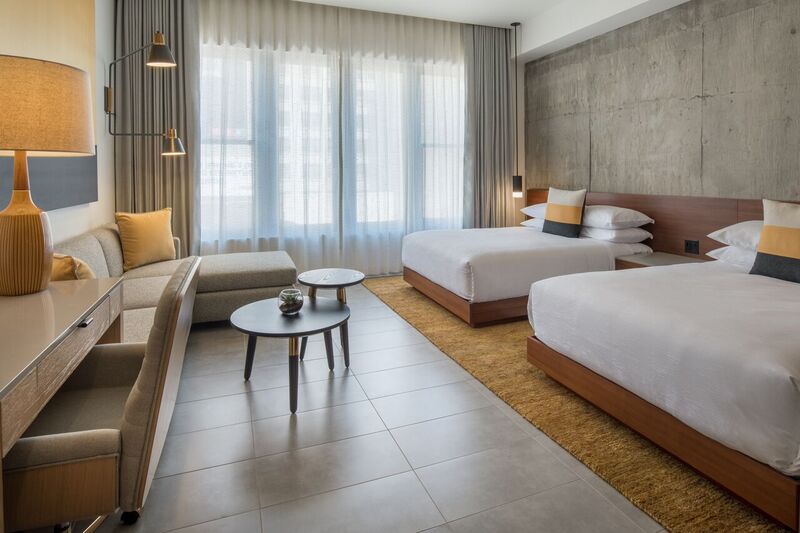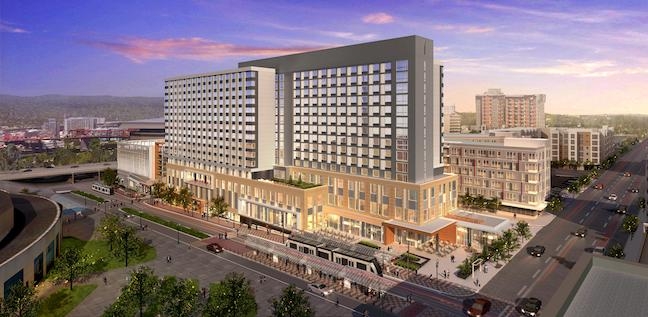Brand Story – A forty percent increase in hotel rooms by 2020 sets the stage for economic growth and exciting possibilities.
In 2017, the Portland region welcomed 8.4 million overnight visitors. Yet between 2009-2016, zero new hotels were built in the city.
In that same time span, hotel occupancy increased from 71% to 81.5% (compared to a national average of 65% in 2017). The average daily rate jumped from $120 to $184.
It was quickly clear: the demand from visitors had outpaced the supply of hotels.
Developers heeded the call. “In 2015, we had roughly 7,000 rooms in Portland. This minute, we’re at 8,660,” said Steve Faulstick, Chief Sales Officer at Travel Portland. “In the next three weeks, we’ll have 500 rooms opening, with another 600 in 2019, and then 600-800 more in 2020. This is both catch up from a stagnant period in development, as well as a reflection of Portland’s very strong appeal for travelers.”
In 2017, visitors to the Portland region generated $256 million in tax revenue, with more than $5.1 billion in direct spending. The tourism industry directly supports 35,300 jobs and generates an estimated $1.3 billion in employment earnings.
“When people visit Portland, we all see the benefits,” said Faulstick. “And now we have the infrastructure to make it more accessible.”
Six hundred of those rooms will come from the Hyatt Regency Portland at the Oregon Convention Center, which is expected to be complete in Fall 2019. The LEED-certified hotel is being developed in partnership between Metro, Hyatt Hotels, and Mortenson Construction in the hopes of attracting and accommodating larger events for the Oregon Convention Center.
“We were missing out on five to ten large- scale conventions per year,” said Heather Back, Communications Manager at Metro. A 2012 study estimated 847,000 rooms were lost regionally due to a competitive citywide hotel package. “The business case was clear: we need this hotel.”

The vision for the Hyatt Regency hotel had existed for more than 30 years. A bond measure was authorized in 2014 to support the hotel’s construction, and would be repaid by revenue from its guests.
Once the booking window opened, 25 future convention groups were confirmed, accounting for 129,863 rooms in the Portland market. Back added: “All 25 of these groups would not have booked in Portland without the new Hyatt Regency hotel.”
Metro estimates conventions bring in $650 million annually (developed in a study by Strategic Advisory Group). The completed hotel is estimated to generate $5.6 million in new state tax revenue and $4.7 million in new local tax revenue.
“Portland’s tourism accomplishments are a direct result of strategic investments made in tourism initiatives with lodging tax revenues,” said Jason Brandt, President & CEO of the Oregon Restaurant & Lodging Association. “If we keep our eye on the prize, Oregon’s tourism potential will continue to grow and strengthen our statewide economy.”
Heather Back – Communications Manager at Metro
Secondary impacts of the hotel’s construction are significant—between 2017 and 2020, 2,000 construction jobs will be created, as well as 950 permanent hospitality positions. Metro, Hyatt, and Mortenson also developed diversity initiatives for the project, working with minority and women-owned contractors and employing economically disadvantaged populations.
Job creation is not reserved for just the new Hyatt Regency hotel. “Generally speaking, one full-time employee is created for every two new hotel rooms,” said Faulstick. “The city expects 4,000-5,000 new rooms by 2020, resulting in, potentially, 2,000-2,500 full-time, family wage jobs.”
Many hotels partnered with Portland-based architecture firms, interior design studios, and contracting companies for the new projects.
Even further, with guests seeking “experiential stays,” partnerships with Portland brands have nearly become a requirement for hoteliers. Marriott’s Hi-Lo Hotel features Pendleton wool, Nossa Familia coffee, Maak Lab soaps and fragrances (among other partnerships); Provenance’s Dossier Hotel fills its rooms with prints, paintings and illustrations by Portland artists and also delivers pints of Salt & Straw to rooms; Hilton’s Canopy Hotel bar serves Willamette Valley wines and Portland-based spirits. Additionally, hotel lobbies often curate local music and art shows.
 Local products are featured in guest rooms at the Hi-Lo Hotel including pillows from Pendleton, reclaimed wood paneling from Pioneer Millworks and bath products from Maak Lab.
Local products are featured in guest rooms at the Hi-Lo Hotel including pillows from Pendleton, reclaimed wood paneling from Pioneer Millworks and bath products from Maak Lab.
Travel Portland connects vendors from My People’s Market—a marketplace which showcases over 80 minority-owned businesses—with hotel operators to help get their products placed and sold within hotels.
According to Faulstick, it’s a “win-win” situation for vendors, guests and hoteliers. “People don’t want to come here and stay in a branded hotel box that looks like anywhere in the U.S.,” said Faulstick. “They want the Portland touch. That is the rule, not the exception. And hotels completely understand this.”
The big question looms: with the surge in new development, can hoteliers maintain occupancy?
“With top tier promotional partners like Travel Portland and Travel Oregon, I think the Portland Metro market is well positioned to meet the challenge of matching newfound supply with increased demand,” said Brandt. “Both organizations continue to receive national attention for their innovative approaches to tourism promotion and Oregon’s economy benefits as a result.”
Hotel development has a compounding effect. Once a city increases its capacity for hosting events, it’s able to attract larger opportunities. Major events not only generate hundreds of millions of dollars in tourist spending and lodging tax, but they also lend national and international exposure from media coverage, all of which encourages further tourism.
 Mortenson, Metro and Oregon Convention Center staff commemorate hotel topping off with 28 trades. – photo by Grady Wheeler
Mortenson, Metro and Oregon Convention Center staff commemorate hotel topping off with 28 trades. – photo by Grady Wheeler
In 2016, Portland was able to host the IAAF World Indoor Championships, the first U.S. host since 1987. There is now the potential to host an NBA All-Star Game (previous bids were rejected, as NBA Commissioner Adam Silver cited “a shortage of hotel rooms”).
IndyCar’s GrandPrix races returned in 2018 after a 10-year absence, which brought further national exposure.
“We already have the magic wand, being our people and our experience,” said Faulstick. “But we needed better awareness and distribution. Now that we have this infrastructure, we’re on a totally different stage for major opportunities.” He added: “We’re on the cusp of a spectacular future. I think of where Portland will be in a few years and I couldn’t be more excited.
Brand stories are paid content articles that allow Oregon Business advertisers to share news about their organizations and engage with readers on business and public policy issues. The stories are produced in house by the Oregon Business marketing department. For more information, contact associate publisher Courtney Kutzman.


